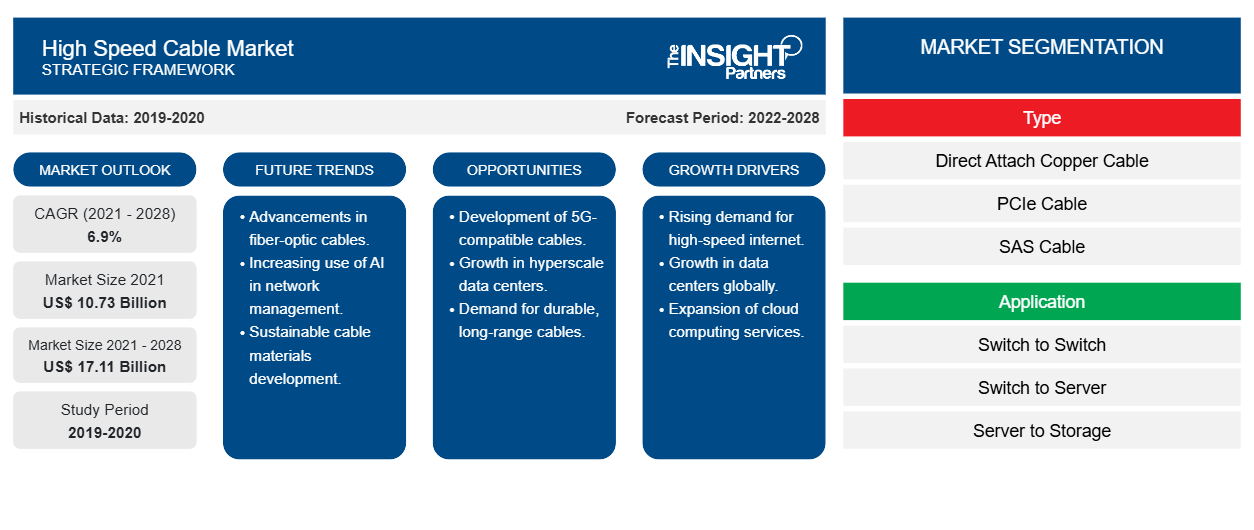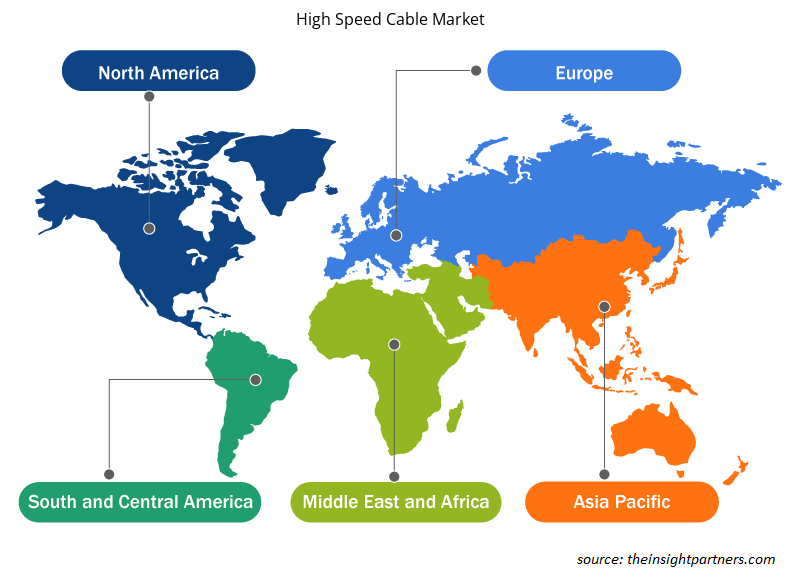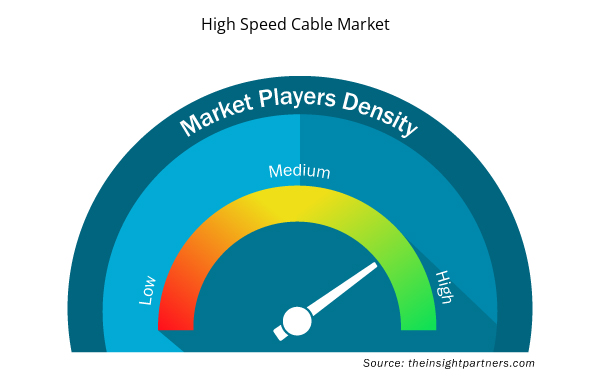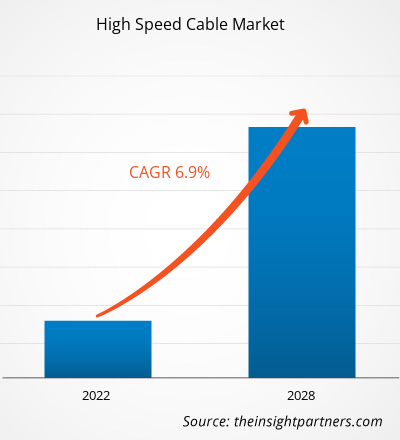The high speed cables market size is projected to reach US$ 24.99 billion by 2031 from US$ 12.90 billion in 2024. The market is expected to register a CAGR of 10.2% during 2025–2031. The emergence of smart cities is likely to bring new trends into the market in the coming years.
High Speed Cables Market Analysis
As cloud services expand at an unprecedented pace, the demand for high-performance, cost-effective data center interconnects is rapidly increasing. This has led to the growing adoption of high-speed cables. Unlike optical interconnects that rely on optical modules for signal conversion, high-speed cables such as Direct Attach Copper (DAC) and Active Optical Cables (AOC) provide a direct physical layer connection between two ports using twin-axial cables. This ensures signal integrity over specified distances without the need for active optical components. Industries such as electronics, automotive, communications, and networking are evolving, introducing innovations that support faster data transfer. Consequently, the rising need for efficient connectivity is driving high speed cables market growth. In the automotive sector, manufacturers are increasingly integrating electronic and infotainment systems into vehicles to enhance connectivity, further fueling this demand.
High Speed Cables Market Overview
Data centers require efficient intra-rack and inter-rack connections, and high-speed cables are well-suited for this purpose. They offer rapid connectivity while consuming less than 0.1W of power, generating minimal heat in the process. This energy efficiency helps reduce the cooling load on data center air conditioning systems. Additionally, high-speed cables offer excellent durability, making them less prone to damage from bending or physical stress. This robustness minimizes the risk of failures in high-density environments, providing a significant advantage in data center operations.
Customize This Report To Suit Your Requirement
You will get customization on any report - free of charge - including parts of this report, or country-level analysis, Excel Data pack, as well as avail great offers and discounts for start-ups & universities
High Speed Cables Market: Strategic Insights

- Get Top Key Market Trends of this report.This FREE sample will include data analysis, ranging from market trends to estimates and forecasts.
You will get customization on any report - free of charge - including parts of this report, or country-level analysis, Excel Data pack, as well as avail great offers and discounts for start-ups & universities
High Speed Cables Market: Strategic Insights

- Get Top Key Market Trends of this report.This FREE sample will include data analysis, ranging from market trends to estimates and forecasts.
High Speed Cables Market Drivers and Opportunities
Developments in 5G Network Services
Passive DACs, which are basically premium copper wires without any embedded electronics, are less expensive than the cables due to these components. Advanced chipsets in AECS and VCSEL lasers in AOCS add a premium that can increase the cost by at least two to five times. DACs are frequently utilized in 5G networks for short-range connections that occur in the same area, such as O-RAN cell sites and edge data centers. These cables support high-speed data transport with low latency and power consumption. For instance, passive QSFP28 DACs are appropriate for in-cabinet direct connections since they can support 100 Gb/s, while SFP28 DACs can support 25 Gb/s. The dense cells and high traffic of 5G networks necessitate backhaul connections capable of handling hundreds of gigabits. This necessitates greater speed Ethernet connections, such as 400G or greater. DACs are essential in order to facilitate these high-speed Ethernet connections across short distances and guarantee effective data transfer between network devices. The lowest power consumption per port is also provided by passive DACs, which use between 91% and 97% less power per port than fiber cabling with independent transceivers. The volume of short-reach server network access connections quickly mounts up.
Growing Deployment of Data Centers
The rise in internet consumption and the development of advanced software solutions have fueled the volume of data generation worldwide. The need for processing and storing huge amounts of data has propelled organizations to adopt advanced processing and storage solutions, driving the deployment of data centers. With the growing trend of digitalization, data centers have become a paramount aspect of the modern industry and economy. Data centers play a vital role in cloud computing. As the industry is moving toward the adoption of cloud technology owing to its cost and operational advantages, SMEs are at the forefront of the adoption of this technology. Further, complex cloud computing operations are done by large tech companies and research institutions. Active optical cables, direct attach copper cables, and fiber optic cables are among the widely used high-speed cables in data centers.
High Speed Cables Market Report Segmentation Analysis
Key segments that contributed to the derivation of the high speed cables market analysis are component, end user, and connectivity.
- Based on the type, the market is segmented into direct attach copper (DAC) cable, active optical cable (AOC), active copper cable (ACC), PCIe cable, active electrical cable (AEC), and SAS cable. The active optical cable (AOC) segment held the largest share of the market in 2024.
- Based on application, the market is segmented into switch to switch interconnect, switch to server, and server to storage interconnect. The switch to switch interconnect segment held the largest share of the market in 2024.
High Speed Cables Market Share Analysis by Geography
The geographic scope of the high speed cables market report is divided into five regions: North America, Asia Pacific, Europe, Middle East and Africa, and South and Central America.
Asia Pacific held a significant market share in 2024. Asia Pacific is the fastest-growing region for high-speed cable demand, owing to rapid urbanization, exponential growth in internet users, and technological advancements in countries such as China, Japan, South Korea, and India. The expansion of 5G networks, large-scale data center construction, and a booming EV market are creating substantial opportunities for high-speed cable deployment across telecommunications, transportation, and energy sectors.
The automotive industry in Asia Pacific is another major contributor to the growing demand for high-speed cables. In China, Japan, South Korea, and other countries, automotive manufacturers require high-speed cables for the transmission of image data, multifunction displays, and infotainment systems for rear-seat passengers, and other applications, with the rise of electric vehicles (EVs). China, as the largest EV market globally, sets ambitious targets for electric mobility, driving the demand for high-performance components. According to the International Energy Agency (IEA), the significant growth in electric vehicle (EV) adoption in China, with new electric car registrations reaching 8.1 million in 2023, an increase of 35% from 2022, highlights the growing demand for high-speed cable in the automotive industry. This surge in EV production is closely linked to the increasing high-speed cables, particularly in Asia Pacific. High-speed cables in automotive applications facilitate rapid data transmission for features such as advanced driver-assistance systems (ADAS), infotainment systems, and camera systems. They also enable vehicle-to-vehicle (V2V) and vehicle-to-infrastructure (V2X) communications.
High Speed Cables Market Regional Insights
The regional trends and factors influencing the High Speed Cables Market throughout the forecast period have been thoroughly explained by the analysts at Insight Partners. This section also discusses High Speed Cables Market segments and geography across North America, Europe, Asia Pacific, Middle East and Africa, and South and Central America.

- Get the Regional Specific Data for High Speed Cables Market
High Speed Cables Market Report Scope
| Report Attribute | Details |
|---|---|
| Market size in 2024 | US$ 12.90 Billion |
| Market Size by 2031 | US$ 24.99 Billion |
| Global CAGR (2025 - 2031) | 10.2% |
| Historical Data | 2021-2023 |
| Forecast period | 2025-2031 |
| Segments Covered |
By Type
|
| Regions and Countries Covered | North America
|
| Market leaders and key company profiles |
High Speed Cables Market Players Density: Understanding Its Impact on Business Dynamics
The High Speed Cables Market is growing rapidly, driven by increasing end-user demand due to factors such as evolving consumer preferences, technological advancements, and greater awareness of the product's benefits. As demand rises, businesses are expanding their offerings, innovating to meet consumer needs, and capitalizing on emerging trends, which further fuels market growth.
Market players density refers to the distribution of firms or companies operating within a particular market or industry. It indicates how many competitors (market players) are present in a given market space relative to its size or total market value.
Major Companies operating in the High Speed Cables Market are:
- Amphenol Corporation
- Axon Cable SAS
- Molex LLC
- Volex PLC
- NVIDIA CORPORATION
- Samtec INC
Disclaimer: The companies listed above are not ranked in any particular order.

- Get the High Speed Cables Market top key players overview
High Speed Cables Market News and Recent Developments
The high speed cables market is evaluated by gathering qualitative and quantitative data post primary and secondary research, which includes important corporate publications, association data, and databases. A few developments in the high speed cables market are listed below:
- Amphenol Communications Services (ACS), a global leader in high-performance interconnect solutions, and Semtech Corporation (Nasdaq: SMTC), a leading provider of high-performance semiconductor, Internet of Things (IoT) systems and cloud connectivity service solutions, introduced a leading-edge 1.6T OSFP Active Copper Cable (ACC) product featuring Semtech’s CopperEdge 224G/lane linear equalizer/redriver ICs, targeted for use in next-generation AI/ML and data center infrastructure. (Source: Amphenol Communications, Press Release, April 2025)
- Samtec released a new High-Speed Cable Design Guide full of new products, technologies, and roadmap items. The Guide highlights Samtec’s innovation for next-generation architectures – Flyover, HDR, Optics, and RF solutions combined with industry-leading support, in-house manufacturing, and customization capabilities to create a solution for any application. (Source: Samtec, Press Release, June 2023)
High Speed Cables Market Report Coverage and Deliverables
The "High Speed Cables Market Size and Forecast (2021–2031)" report provides a detailed analysis of the market covering below areas:
- High Speed Cables market size and forecast at global, regional, and country levels for all the key market segments covered under the scope
- High Speed Cables market trends, as well as market dynamics such as drivers, restraints, and key opportunities
- Detailed PEST and SWOT analysis
- High Speed Cables market analysis covering key market trends, global and regional framework, major players, regulations, and recent market developments
- Industry landscape and competition analysis covering market concentration, heat map analysis, prominent players, and recent developments for the High Speed Cables market
- Detailed company profiles
- Historical Analysis (2 Years), Base Year, Forecast (7 Years) with CAGR
- PEST and SWOT Analysis
- Market Size Value / Volume - Global, Regional, Country
- Industry and Competitive Landscape
- Excel Dataset



Report Coverage
Revenue forecast, Company Analysis, Industry landscape, Growth factors, and Trends

Segment Covered
Type and Application

Regional Scope
North America, Europe, Asia Pacific, Middle East & Africa, South & Central America

Country Scope
Argentina, Australia, Brazil, Canada, China, France, Germany, India, Italy, Japan, Mexico, Russian Federation, Saudi Arabia, South Africa, South Korea, United Arab Emirates, United Kingdom, United States
Frequently Asked Questions
What is the expected CAGR of the high speed cable market?
The market is anticipated to expand at a CAGR of 10.2% during 2025-2031.
What are the driving factors impacting the high speed cable market?
Growing deployment of data centers and rising investments in enterprise IT infrastructure are driving the market growth.
What are the future trends of the high speed cable market?
Emergence of smart cities are key trends in the market.
Which are the leading players operating in the high speed cable market?
Amphenol Corporation; Axon Cable SAS; Molex LLC; Volex PLC; and NVIDIA CORPORATION are major players in the market.
What would be the estimated value of the high speed cable market by 2031?
The market is expected to reach a value of US$ 24.99 billion by 2031.
Trends and growth analysis reports related to Electronics and Semiconductor : READ MORE..
The List of Companies - High Speed Cable Market
- Amphenol Corporation
- Axon Cable SAS
- Molex LLC
- Volex Plc
- NVIDIA Corp
- Samtec Inc
- Shenzhen Sopto Technology Co., Ltd.
- TE Connectivity Ltd
- JPC Connectivity
- EDGE Optical Solutions

 Get Free Sample For
Get Free Sample For